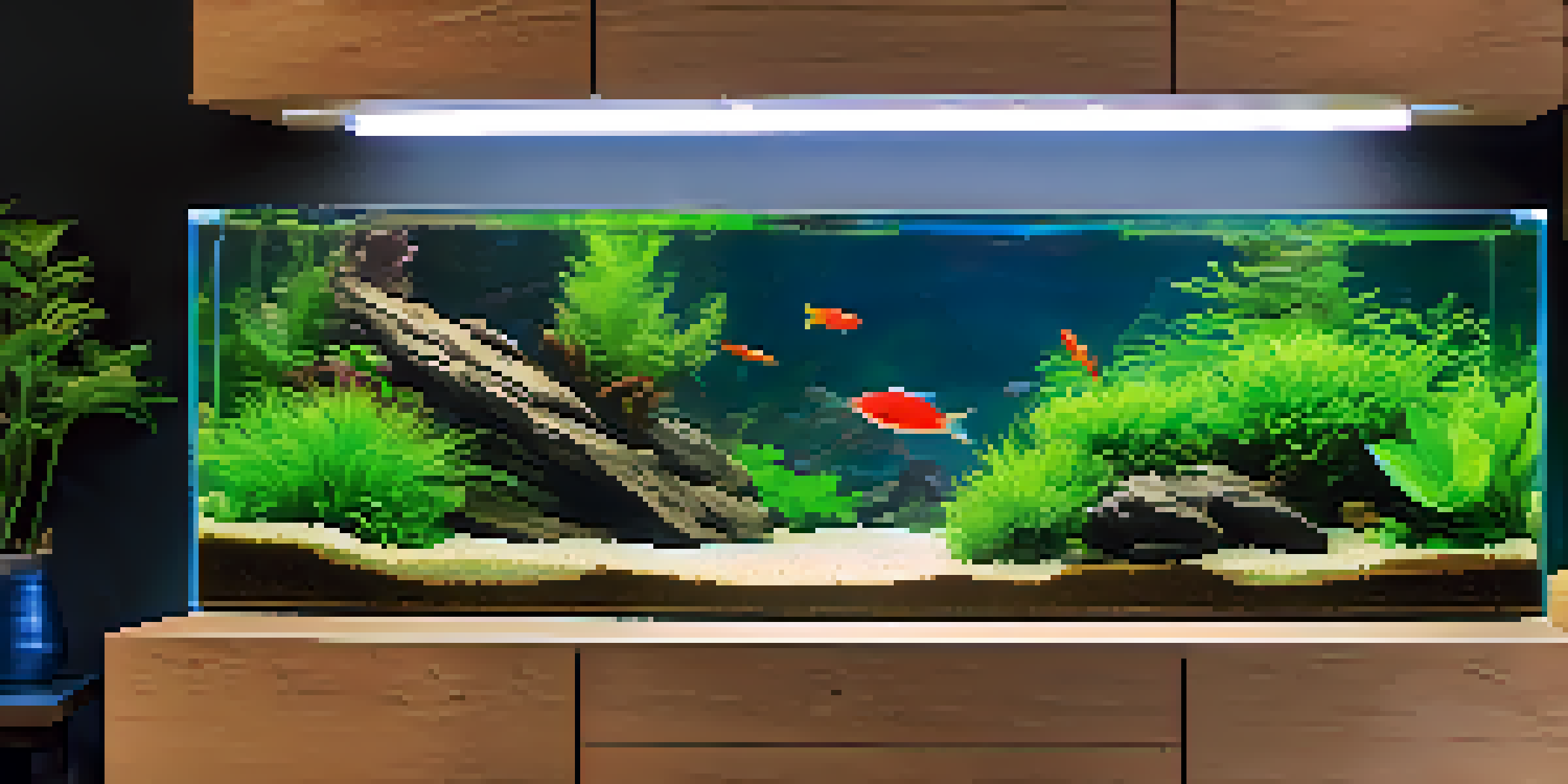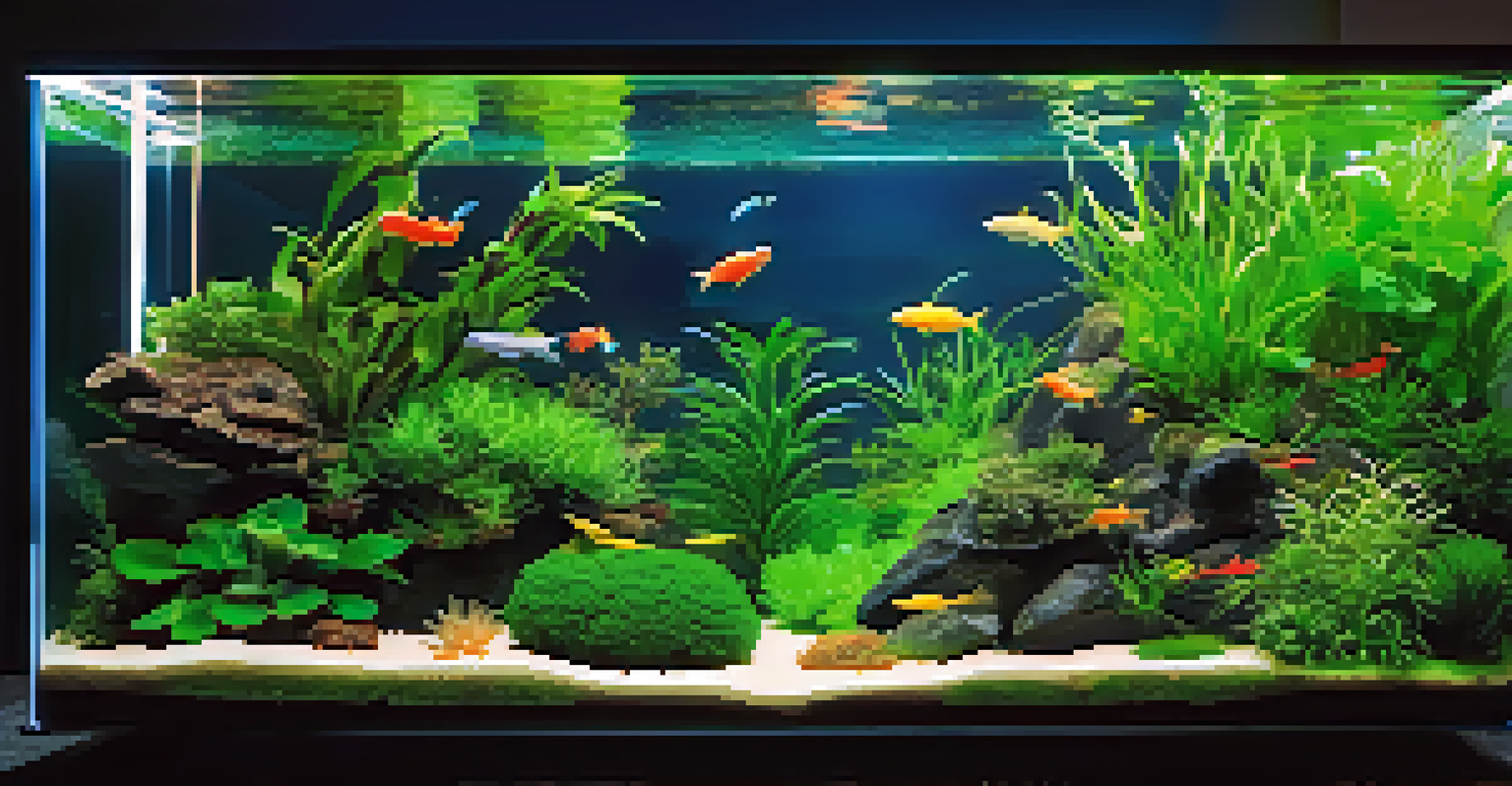Lighting Techniques to Enhance Your Aquascaping Design

Understanding the Importance of Aquascaping Lighting
Lighting plays a crucial role in aquascaping, not just for aesthetics but also for the health of your aquatic plants and fish. The right light can enhance colors and textures, creating a vibrant underwater landscape. Furthermore, proper lighting can influence plant growth, photosynthesis, and even algae control.
The light of the world is not only the sun, but also the light we create in our own lives.
When setting up your aquascape, consider how natural light interacts with your aquarium. This can guide your choices in artificial lighting, making your setup appear more natural and harmonious. Ultimately, the goal is to create a balanced environment where both plants and fish thrive.
By understanding the significance of lighting in your design, you can make informed decisions that enhance both beauty and functionality. The right lighting can transform your aquarium into a stunning focal point in your home.
Types of Lighting for Aquascaping
There are several types of lighting to consider when planning your aquascape, including LED, fluorescent, and incandescent options. LEDs are popular for their energy efficiency and long lifespan, while fluorescent lights provide a broad spectrum of color. Incandescent bulbs, though less common, can add a warm glow but are less effective for plant growth.

Each type of lighting has its advantages and disadvantages, and your choice will depend on the specific needs of your plants and the overall look you aim to achieve. For instance, if you're growing delicate plants, a full-spectrum LED might be your best bet. Alternatively, if you want a dramatic effect, a combination of different lights may work wonders.
Lighting's Role in Aquascaping
Proper lighting is essential for the health of aquatic plants and fish, enhancing aesthetics while promoting growth.
Understanding these options empowers you to tailor your lighting setup to suit your aquascaping goals. The right type of light can make all the difference in showcasing your aquatic masterpiece.
Creating Depth with Strategic Lighting Placement
Strategic placement of lights can create depth and dimension in your aquascape. By positioning lights at varying angles and heights, you can cast shadows and highlights that enhance the three-dimensionality of your setup. This technique draws the eye and adds visual interest to your underwater landscape.
Nature does not hurry, yet everything is accomplished.
Consider using a combination of overhead lighting and spotlights to highlight specific features, such as rocks or plants. This method not only showcases your design but also mimics natural light patterns found in aquatic environments. It's like painting with light, bringing your aquascape to life.
Experimenting with different placements and intensities will help you discover what works best for your unique aquarium. This thoughtful approach can elevate your aquascaping to new heights.
Adjusting Light Intensity for Plant Health
Not all plants require the same intensity of light, making it essential to adjust your lighting setup accordingly. Low-light plants like Java Fern thrive in softer light, while high-demand species such as Amazon Sword need brighter illumination to flourish. Understanding these needs can prevent issues like stunted growth or algae blooms.
Using a dimmer switch or adjustable LED lights allows you to customize light intensity based on the specific requirements of your plants. You can also observe how your plants respond over time and make necessary adjustments. This flexibility is key to maintaining a healthy aquascape.
Types of Lighting Options
Choosing the right lighting type, such as LEDs or fluorescent lights, is crucial for matching the needs of your plants and achieving desired visual effects.
By being mindful of light intensity, you can foster a thriving environment that promotes lush growth and vibrant colors. It’s all about finding the right balance for your aquatic friends.
Utilizing Color Temperature to Set the Mood
Color temperature refers to the warmth or coolness of light, measured in Kelvin. Cooler temperatures (around 6500K) mimic daylight and are great for plant growth, while warmer lights (around 3000K) create a cozy ambiance. Understanding this concept allows you to set the mood for your aquarium.
For instance, if you want to create a serene, natural look, consider using lights with a color temperature that reflects a sunny day. Conversely, if you're aiming for a more dramatic effect, warmer lights can enhance the colors of your fish and plants, making them pop.
By playing with color temperature, you can transform the atmosphere of your aquascape, evoking different feelings and experiences for anyone who gazes into it. This subtle manipulation can make your aquarium truly captivating.
Timing Your Lighting: The Importance of a Schedule
Just as humans require a regular sleep schedule, aquatic plants and fish thrive on a consistent lighting routine. A lighting schedule mimics natural day-night cycles, which is vital for the health of your ecosystem. Most aquarists recommend 8 to 10 hours of light per day for balanced growth.
Using timers can simplify this process, ensuring that your lights turn on and off at the same time each day. This not only reduces the risk of overexposure to light but also helps establish a stable environment for your aquatic life. It’s a simple yet effective way to promote a healthy aquascape.
Importance of a Lighting Schedule
Establishing a consistent lighting schedule mimics natural day-night cycles, benefiting both aquatic plants and fish in your aquarium.
By maintaining a consistent lighting schedule, you create a reliable routine that benefits both your plants and fish. This consideration is essential for a thriving aquarium.
Troubleshooting Common Lighting Issues
Even with the best intentions, lighting issues can arise in any aquascape. Common problems include poor plant growth, excessive algae, or uneven lighting. It's crucial to identify these issues early to prevent long-term damage to your aquarium setup.
If you notice algae overgrowth, it may be a sign of too much light or an imbalanced nutrient system. On the other hand, if your plants appear leggy or pale, they might not be receiving enough light. Regular monitoring and adjustments will help you maintain a healthy balance.

Having a troubleshooting plan can save you time and frustration. By understanding these common issues and their solutions, you can keep your aquascape flourishing and visually stunning.